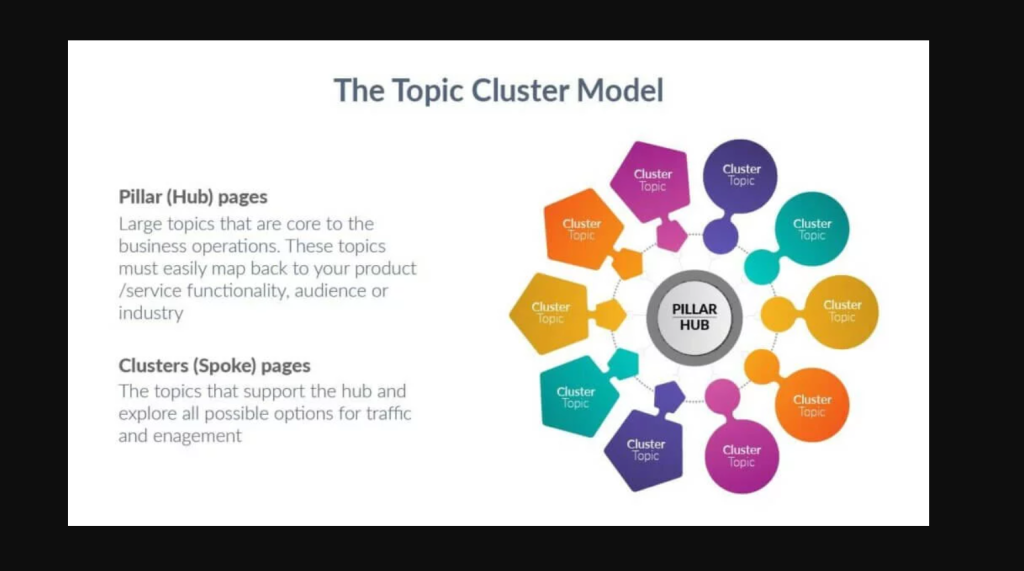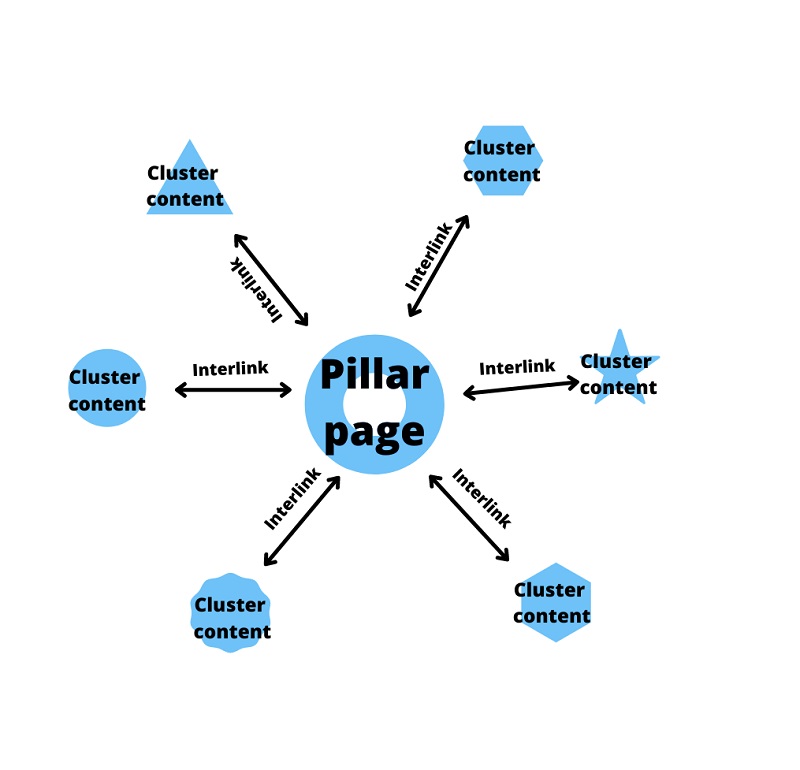The most transformative change in SEO Content Planning came when search engines, especially Google, began prioritizing user experience and content relevance over mere keyword presence.
This ultimately led to the rise of topic clusters, and websites started focusing on implementing this SEO Content Strategy.
Instead of creating isolated pieces of content targeting specific keywords, the focus shifted to building interconnected content around a central theme or topic.
Consequently, proper internal linking practices within topic clusters improve the depth and breadth of your website’s content and enhance the user’s navigational experience.
This article aims to elucidate the best internal linking practices in a Topic Cluster.
Table of Contents
The Main Components of a Topic Cluster
At its core, a topic cluster strategy is a method of organizing content where a single “pillar” page acts as the main hub, and multiple related articles or “cluster content” link back to this hub.
Each of these cluster contents delves deeper into specific subtopics of the main theme.

To fully grasp and Understand Topic Clusters in SEO, it’s essential to start by highlighting its main components. These entail;
Pillar Page
Acting as the central hub, “pillar pages” provide a comprehensive overview of a broad topic, linking out to related subtopics.
Unlike regular blog posts or articles that might focus on a narrow aspect, a pillar page covers the main theme/topic in depth, aiming to provide a 360-degree view of the subject.
As such, they serve as the foundation upon which cluster content is built.
Cluster Content
While pillar pages lay the foundation, cluster content adds depth and dimension to the topic cluster strategy. These are the branches that sprout from the main trunk (pillar page), each focusing on a specific subtopic or aspect of the broader theme.
Often referred to as “cluster articles” or “subtopic content,” they are shorter, more focused articles that delve into specific facets of the main topic covered in the pillar page.
They can also target long-tail keywords and address particular questions or concerns related to the overarching theme.
Together, they create a cohesive web of information mentioned on the Pillar page that offers readers a comprehensive understanding.
Keyword Clusters
Keyword clusters are groups of related keywords that revolve around a central theme or topic. Unlike standalone keywords, they encompass a range of search terms, from broad-head keywords to specific long-tail keywords.
In general, a topic cluster comprises multiple keyword clusters that are used to ideate topical coverage. They ensure your content aligns with user queries and search engine algorithms, paving the way for enhanced visibility and engagement.
Internal Links
Internal linking, the practice of connecting different pieces of content within the same website, is a cornerstone of the topic cluster strategy.
It not only enhances user navigation but also plays a pivotal role in SEO, distributing page authority, and guiding search engine crawlers.
Best Internal Linking Practices within Topic Clusters
When internal linking within topic clusters, it’s not just about connecting pages.
Rather, it’s about strategically guiding both users and search engines through a cohesive journey, from the overarching theme on the pillar page to the specifics of the cluster content, and vice versa.
This interlinking communicates the depth, breadth, and structure of your content, emphasizing its relevance and authority.

Link juice” is a colloquial term used in this context to describe the value or equity passed from one page or site to another through hyperlinks.
Ideally, when one page links to another, it essentially “votes” for that page, telling search engines that the content is valuable or trustworthy.
The more high-quality votes (or links) a page gets, the more authority it has, which can positively influence its search engine rankings.
Best Practices for Internal Linking Pillar Pages and Content Clusters
1. Descriptive Anchor Texts:
Use clear, keyword-rich anchor texts that give users and search engines an idea of the linked page’s content.
For instance, if linking to a cluster content about “Email Marketing Tips” from a pillar page on “Digital Marketing,” the anchor text might be “in-depth email marketing strategies.”
2. Two-Way Linking:
Every piece of cluster content should link back to its associated pillar page, and the pillar page should, in turn, link to each piece of cluster content.
This creates a bi-directional flow, reinforcing the relationship between the main topic and its subtopics.
3. Avoid Link Overload:
While it’s essential to interlink content, avoid overwhelming users with too many links in a short section.
Links should feel natural and add value to the reader.
4. Contextual Relevance:
Ensure that the internal links are contextually relevant.
This means that the surrounding content should align with the topic of the linked page, providing a seamless transition for the reader.
5. Prioritize User Experience:
While SEO is crucial, user experience should always be the priority.
Links should be easily identifiable, and their destination should match the user’s expectation based on the anchor text.
Internal Linking Tools and Techniques
- Visual Mapping:
Before implementing, visually map out your topic cluster with tools like MindMeister or Lucidchart.
This gives a clear picture of how content pieces interrelate.
- Heatmaps:
Tools like Hotjar can provide insights into how users navigate your content.
If they’re frequently using your internal links, it’s a sign they’re finding them valuable.
- SEO Crawlers:
Tools like Screaming Frog and PowerSuite Website Auditor can help ensure that all internal links within your topic cluster are functional and not lead to broken pages.
Benefits of Interlinking Between Pillar Pages and Cluster Contents
Ideally, interlinking within topic clusters is important for a number of reasons:
Strengthening the Pillar Page:
As we earlier mentioned, In a topic cluster, the pillar page is the central hub, providing a comprehensive overview of a broad topic.
Therefore, by linking all related cluster content back to this pillar page, you’re funneling link juice to it, reinforcing its authority and importance.
Boosting Cluster Content:
Conversely, when the pillar page links out to its associated cluster content, it distributes its link juice, helping to elevate the authority of these more specific, detailed pages.
This bi-directional flow ensures that all content within the topic cluster benefits.
SEO Benefits:
Properly internal linking practices within topic clusters help search engines understand the relationship between the pillar page and its associated cluster content.
This can lead to improved indexing and better rankings for both broad and long-tail keywords.
User Navigation:
For users, a well-implemented topic cluster with strategic internal linking provides a roadmap.
As users explore a topic, they can easily move between the pillar page and related cluster content, encouraged by the strategic internal links.
This can lead to longer site visits and reduced bounce rates.
Content Hierarchy:
Best Internal linking practices within topic clusters establish a clear content hierarchy, signaling the importance of the pillar page as the central hub and the cluster content as its spokes.
Improved Indexation and Visibility:
As link juice flows through the topic cluster, it aids in faster and more efficient indexing of the content by search engines.
This can lead to better visibility and higher rankings for both the pillar page and its associated cluster content.
FINAL THOUGHTS
Internal linking within topic clusters should be a strategic endeavor. It’s about creating a web of interconnected content that offers users a comprehensive understanding while signaling to search engines the depth and structure of your content. When executed correctly, it can significantly elevate the effectiveness of your topic cluster strategy.



